Tower Garden Tips: Easy Ways to Boost Your Indoor Harvest
Growing your own food can be a fun and rewarding experience. If you’re short on space or just want to try something new, a tower garden might be the perfect solution for you. A tower garden allows you to grow a variety of plants vertically, making it ideal for small spaces such as patios, balconies, or even indoors.

How can you make the most out of your tower garden? With a few essential tips and tricks, you can ensure that your plants thrive and produce an abundant harvest. From choosing the right location to properly maintaining your system, these helpful pointers will guide you toward successful tower gardening.
1) Prune Regularly

Pruning is important for your tower garden. It helps plants grow better and keeps them healthy.
Remove dead or yellow leaves from your plants. This stops diseases from spreading and lets the plant focus on healthy growth.
Trim back any overgrown sections. This improves air circulation and light exposure, which is good for your plants. Happy gardening!
2) Use High-Quality Seeds

Choosing the right seeds is crucial for a successful Tower Garden. High-quality seeds increase the chances of growing strong, healthy plants.
Look for seeds from reputable suppliers. They often provide varieties that are well-suited for your specific climate and growing conditions.
High-quality seeds tend to have better germination rates, meaning more of them will sprout successfully and grow into robust seedlings. Your Tower Garden will benefit from the best start possible.
3) Monitor Water Levels

Check your Tower Garden’s water levels regularly. If the stick on your water monitor reads at the 1/2 mark or less, add more water.
Keeping enough water and nutrient solution in your reservoir helps your plants grow strong. Your pump should always be submerged to work properly.
Adjust the app settings to help you keep track of water and nutrients easily.
4) Opt for Organic Nutrients

Using organic nutrients in your Tower Garden can help you grow healthier plants. These nutrients are free from synthetic chemicals, making them safer for you and the environment.
Many Tower Gardeners use organic options because they promote strong plant growth and improve soil health. You can find organic fertilizers designed for Tower Gardens.
Organic nutrients often include compost teas or seaweed extracts. These are great for providing essential minerals and vitamins. Make sure to follow the instructions to get the best results for your Tower Garden.
5) Rotate Your Crops

Rotating your crops in a tower garden helps keep the soil healthy and free from pests and diseases. By changing the locations of your plants, you prevent pests and diseases from building up over time.
Plan to switch the spots of your leafy greens, herbs, and other veggies every growing season. This practice can also balance nutrient use in your garden, ensuring that no single nutrient gets depleted.
For a successful rotation, divide your tower garden into sections. Rotate crops in these sections to keep your garden thriving. Check out more tips for crop rotation at The Old Farmer’s Almanac.
6) Add Beneficial Insects

Adding beneficial insects to your Tower Garden can help control pests naturally. Ladybugs and lacewings are great choices as they eat harmful insects like aphids.
To attract these helpful bugs, plant flowers like marigolds nearby. You can also buy beneficial insects and release them into your garden. This simple step improves plant health and reduces the need for pesticides.
Discover more tips on adding beneficial insects to your Tower Garden for a thriving ecosystem.
7) Maximize Sunny Spots

Choose a level spot where your plants will get 6-8 hours of full sunlight. This is crucial for their growth and health.
It’s important to avoid places with too much shade from trees or buildings. Ensure the chosen area has enough space, about 3 square feet, for your Tower Garden.
Also, remember to rotate your Tower Garden occasionally to make sure all sides get ample sunlight. If growing indoors, consider using grow lights to mimic the sun’s effect.
For more information on finding the best sunny spots, you can visit The Basics of Growing Outdoors with Tower Garden.
8) Prevent Overcrowding

Make sure your plants have plenty of space to grow. Overcrowding can lead to poor air circulation and stunted growth.
Check the recommended spacing for each type of plant. This helps ensure each plant gets the light and nutrients it needs.
When planting seeds or seedlings, give each one enough room to thrive. Removing weaker plants can also help the remaining ones grow better. For more tips, you can visit Tower Gardening for Beginners.
9) Use Support Structures

Supporting your plants is key to a healthy Tower Garden. Many plants, like tomatoes and cucumbers, need extra help to stand tall.
Use stakes, cages, or trellises to keep your plants upright. This helps them grow better and makes it easier for you to care for them.
For plants that climb, like beans or peas, a trellis works best. Attach them gently to avoid damage.
10) Check pH Levels

Keeping an eye on your tower garden’s pH levels is crucial for healthy plants. Most plants thrive with a slightly acidic pH of around 6.
Check the pH weekly and adjust if needed. A pH that is too high or too low can prevent your plants from absorbing nutrients well. Keep it between 5 and 7 for best results.
Look out for yellowing leaves. This can signal that your pH might be off. Adjusting the pH can help restore your plants’ vitality. Make sure to follow proper instructions for any adjustments.
Benefits of Using a Tower Garden

Tower gardens bring great advantages, particularly for those with limited space and a desire for sustainable gardening. They use efficient water systems while being easy to maintain.
Saves Space
Tower gardens are vertical, which means they take up a lot less room than traditional gardens. You can grow plants in vertical columns, allowing for more crops in a smaller area. This is perfect for patios, balconies, or even rooftops.
With less space needed, you can enjoy fresh produce without a large backyard. You just stack the plants upwards, saving your ground space for other activities. Because they use vertical columns, the gardening area can be compact.
Efficient Water Usage
Tower gardens use up to 98% less water than traditional gardening. This is mainly because of the closed-system technology they use. The water and nutrients cycle through the system continuously, reducing wastage. This is perfect if you live in a dry area or are looking to save on your water bill.
Because these gardens recycle the same water, you don’t have to keep adding more. This makes them an environmentally-friendly option.
Easy Maintenance
Maintaining a tower garden is simple. Once you set everything up, there are just a few minor tasks to keep things running smoothly. Tasks like checking the water level and adding nutrients are quick and easy.
You don’t need to worry about weeding, as there is no soil. Pests are also less of a problem. This makes it ideal for a busy lifestyle. You can easily keep your garden thriving with minimal effort, enjoying fresh produce with little hassle.
Optimal Conditions for Tower Gardens

To get the most out of your Tower Garden system, it’s essential to focus on the light, temperature, and nutrients. These are the key factors that affect plant growth and health.
Light Requirements
Your Tower Garden plants need plenty of light to thrive. Most crops require 6-8 hours of full sunlight each day. If your garden is outdoors and only one side gets the sun, rotate the tower daily by a quarter turn. This will ensure that all plants receive even exposure.
If you are growing plants indoors, you can use grow lights to simulate sunlight. LED grow lights are a great option because they are energy-efficient and provide the proper wavelengths for plant growth. Place the lights about 12-18 inches above your plants.
Full spectrum LED grow lights offer the best results, mimicking natural sunlight. Ensure that the lights are on for the same hours as needed by the plants outdoors.
Ideal Temperature
Temperature plays a crucial role in the growth of your Tower Garden plants. Most plants thrive in temperatures between 65-75°F (18-24°C). It’s vital to keep your garden within this range to prevent stress on the plants.
If you are growing indoors, maintaining this temperature is usually straightforward with household heating and cooling systems. However, outdoor growing may require additional attention. During hot summer months, you might need to provide shade or move the garden to a cooler spot if temperatures exceed 85°F.
In colder weather, protect your plants by moving them indoors or using covers to trap heat. Remember, extreme temperatures can stunt growth and bring about diseases.
Nutrient Solutions
Proper nutrition is essential for healthy plants. Tower Gardens use a special nutrient solution, which usually includes a mix of primary nutrients (nitrogen, phosphate, and potassium) along with secondary and trace elements.
When mixing your nutrient solution, follow the instructions provided with your Tower Garden kit. A common recommendation is to add 20ml of solution for every gallon of water. Adjustments may be necessary during different seasons. For instance, in summer, you might reduce the amount to 10ml per gallon if temperatures are extremely high.
Always ensure the water and nutrient mix is well-balanced. Test the pH regularly to keep it within the range of 5.5-6.5. Proper nutrient management will ensure that your plants get the necessary nutrition for optimal growth.
You can explore additional growing tips by visiting Growing Tips for more detailed guidelines.
Common Challenges and Solutions

When using a Tower Garden, growers may experience issues with pests, algae, and pH levels. Addressing these problems early on can help maintain a healthy and productive garden.
Pest Management
Pests are a common problem in Tower Gardens. Common pests include aphids, whiteflies, and spider mites. These pests can harm your plants by sucking out nutrients and spreading diseases.
To manage pests:
- Inspect your plants regularly for signs of damage and pests.
- Use natural predators like ladybugs, which can help control aphid populations.
- Apply neem oil or insecticidal soap, which are safe for plants but effective against many pests.
- Maintain good airflow by spacing out plants to discourage pest infestations.
Keeping your garden clean and removing any dead plant material can also help prevent pests.
Dealing with Algae
Algae growth can occur in the Tower Garden, especially at the base of plants. Algae thrives in moist, nutrient-rich environments and can compete with your plants for nutrients.
To deal with algae:
- Cover the base of your plants with opaque material to block light.
- Clean your Tower Garden regularly, particularly the water reservoir.
- Monitor the nutrient levels, as excessive nutrients can fuel algae growth.
- Use hydrogen peroxide solution to clean and prevent algae buildup.
Regular maintenance and adjusting light exposure are key to keeping algae under control.
Maintaining pH Levels
Maintaining proper pH levels is crucial for nutrient absorption in your Tower Garden. Most plants thrive in a pH range of 5.5 to 6.5. Incorrect pH levels can cause nutrient deficiencies or toxicities.
To maintain pH levels:
- Test the water regularly using pH test strips or a digital pH meter.
- Adjust the pH with appropriate solutions: pH up (potassium hydroxide) or pH down (phosphoric acid) as needed.
- Change the water periodically to prevent the buildup of minerals that can affect pH levels.
- Follow the nutrient solution guidelines carefully to avoid pH fluctuations.
Regular testing and adjustments ensure that your plants receive the optimal nutrient uptake for growth.







